Top speed 780 km/h Wingspan 44 m Weight 66,230 kg | Range 5,100 km Cruise speed 750 km/h Unit cost 50,000,000–55,000,000 USD | |
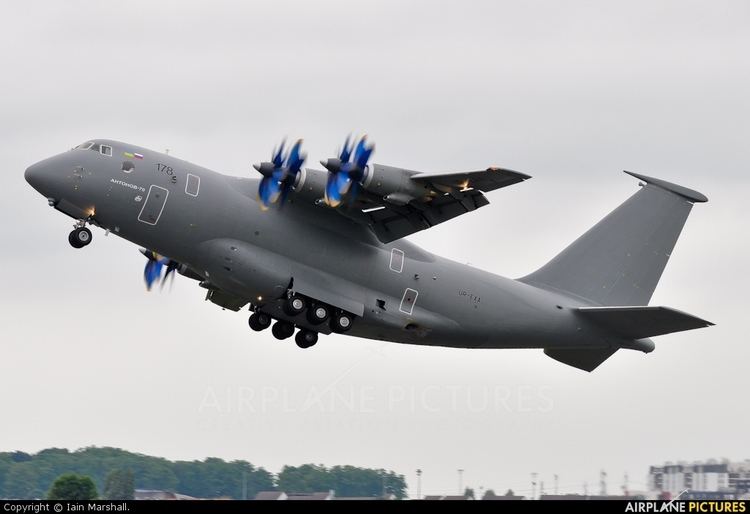 | ||
Antonov an 70 new ukrainian transport aircraft at aviasvit 2008 airshow
The Antonov An-70 is a four-engine medium-range transport aircraft, and the first large aircraft to be powered by propfan engines. It was developed in the late 1980s by the Antonov design bureau to replace the obsolete An-12 military transport aircraft. However, the dissolution of the Soviet Union prevented the mass production of the type. The maiden flight of the first prototype took place on 16 December 1994 in Kiev, now independent Ukraine. Within a year the prototype plane had suffered a mid-air collision. A second airframe was produced and tests continued but numerous further attempts to start production have been unsuccessful.
Contents
- Antonov an 70 new ukrainian transport aircraft at aviasvit 2008 airshow
- Very rare antonov an 70 taking off from leipzig halle airport germany
- Early development and testing history
- An 7X and Future Large Aircraft
- 2001 incident
- Recent development
- Design
- Variants
- Operators
- Specifications An 70
- References

Very rare antonov an 70 taking off from leipzig halle airport germany
Early development and testing history
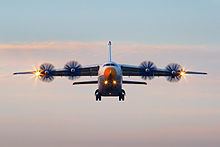
Work on the An-70 began in Soviet Union in 1970s as the country sought a replacement for its An-12 and a complement to the Ilyushin Il-76. The military, with a new emphasis on air mobility, specified an aircraft with short loading and unloading times and the ability to operate from short unprepared airfields. The initial contract to build the An-70 was concluded in May 1989. The Soviet government had shown interest in purchasing 160 planes for its military, but in the post-Soviet days of reduced military budgets in Russia, funding for the An-70 was cut. Antonov decided to proceed with self-funding. There were plans to establish serial production of the model at the Kiev Aircraft Production Plant, which was associated with but separate from the Antonov Design Bureau, and at the Samara Aircraft Production Plant in Samara, Russia. Since Russia was showing reluctance at supporting the development of the An-70, Uzbekistan sought, unsuccessfully, to establish a final assembly plant in the capital at the Tashkent Chkalov Aircraft Production Plant, where the production of the An-70's wings and the Il-76 were taking place.

The maiden flight of the aircraft had originally been scheduled for 1992. However, due to financing and design issues, this was pushed back until 1994. In particular, the weakened condition of the national currency diminished the firm's ability to pay for the aircraft's equipment, especially those sourced from Russia, and workers' salaries. In addition, engineers discovered numerous design and manufacturing deficiencies during the final ground checks, thereby necessitating lengthy corrections. In the end, the aircraft made its maiden flight on 16 December 1994.
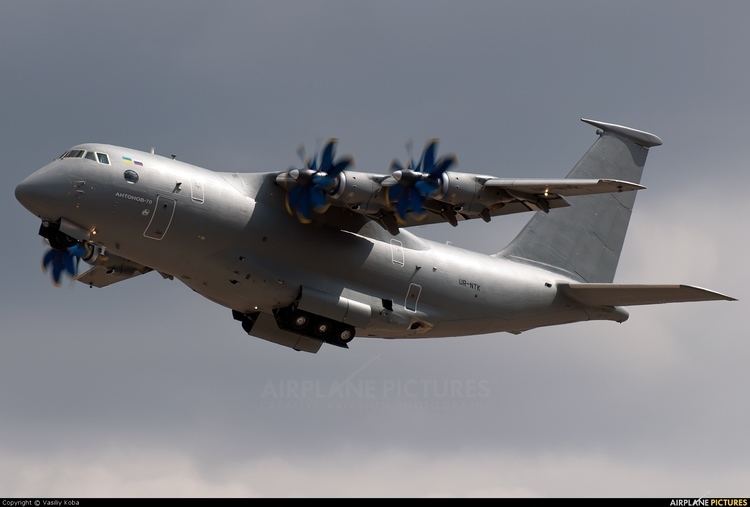
Crewed by a seven-man team, the first aircraft performed a short take off from Svyatoshino airfield, Kiev. This was the first flight of an aircraft that was powered only by propfans. Due to worsening weather conditions over Antonov's headquarters and the flight test area in Kiev, the flight was cut short, and the aircraft's height ceiling was capped at 2,000 m (6,500 ft); the aircraft reportedly attained a height of 450 m (1,475 ft). During the flight, the crew performed basic checkouts of the prototype's systems. After having been airborne for less than half an hour, the aircraft landed at Antonov's flight test facility at Gostomel. Originally, the aircraft was expected to conduct flight tests at the facility for three months before transferring to the Gromov Flight Research Institute in Zhukovsky, near Moscow; Antonov also intended to display the aircraft at that year's Paris Air Show.
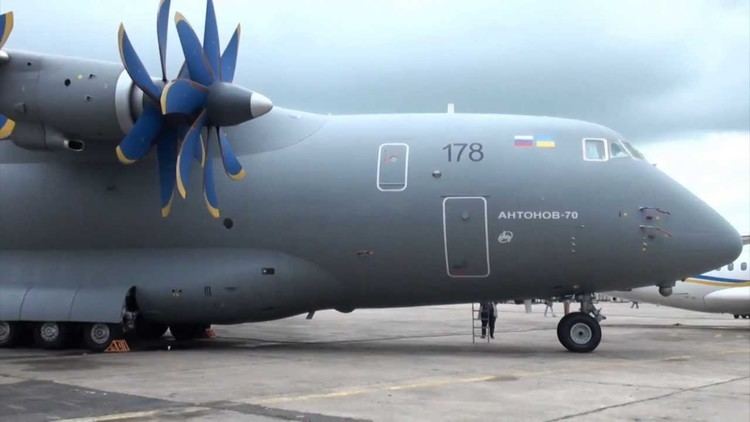
However, the first prototype was lost during its fourth flight on 10 February 1995 in a mid-air collision with an Antonov An-72 being used as a chase plane. During the flight, the aircraft suffered a sudden deviation from its intended flightpath, colliding with the An-72 before spiralling into the ground, erupting into flames; the test crew of seven were killed. Although there were initial allegations of technical issues with the aircraft, it was later determined that the crash had been caused by human error. The aircraft itself proved so promising during its first three flights that Antonov decided to press on and converted the static-test prototype into a flying prototype with a modified flight-control system. The second airframe was rolled out in December 1996 in Kiev, before making its first flight on 24 April 1997 from Svyatoshino airfield, during which the aircraft was airborne for 31 minutes; the aircraft presumably landed at Gostomel before conducting another 26-minute flight. By this time, the Russian and Ukrainian Air Forces were looking to procure 500 and 100 aircraft respectively. Production was expected to have started in 1999 with 20–25 aircraft produced annually.
An-7X and Future Large Aircraft
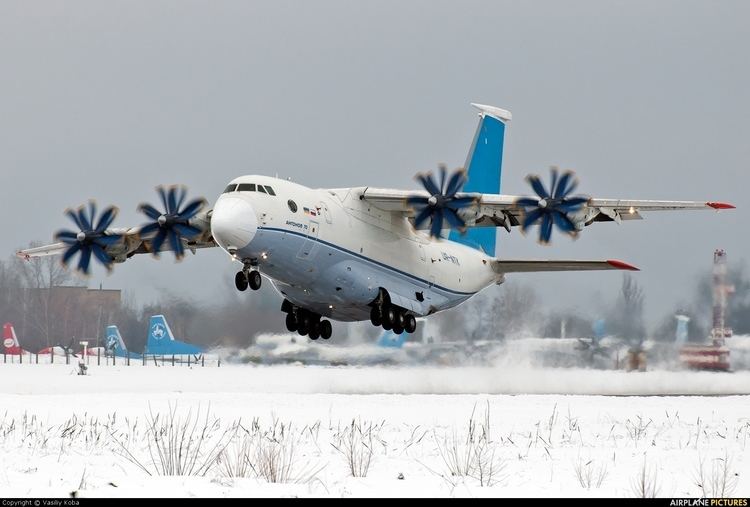
In the early 1990s, the An-70 was unsuccessfully considered as a platform to meet the European Staff Requirement (ESR) for the Future Large Aircraft (FLA) programme to replace the C-130 Hercules. In October 1997, however, the German Defense Minister Volker Rühe announced his intention to study whether the An-70 could be the basis for the FLA. The decision arose out of the German government's objective of providing industrial aid to Eastern Europe. In December 1997, France, Germany, Russia and Ukraine agreed to evaluate the An-70 as a candidate for the FLA programme.

Antonov proposed a "westernised" version of the An-70, the An-7X. The German government tasked DaimlerChrysler Aerospace (DASA) with the responsibility of evaluating the An-70 and assessing whether it would fulfill the ESR for a common tactical airlifter. DASA depended on data provided by Antonov and was not able to test-fly the aircraft themselves. However they conducted wind-tunnel tests and the results confirmed the data. According to the DASA study from 1999 the An-70 fulfilled the ESR, and that westernisation is possible, but work in key areas would have been necessary and risks existed. Areas identified include the introduction of a FADEC, completely new cockpit, new flight-control system computer, fuel-jettison system and in-flight refuelling capability, the cargo-handling system and the loadmaster station. DASA recommended a change in the manufacturing method of the carbon-fiber-reinforced polymer components. Also the fuselage manufacturing-method was considered uneconomical. They were not able to assess the manufacturing of the wing because no data were available. German, Ukrainian and Russian companies had formed the joint-venture "Airtruck" to plan and manage the modifications needed to westernise the An-70.

The German government, for political reasons, preferred the An-70-based solution, while the industry, DASA, preferred the A400M from the military branch of Airbus; DASA refused to be the prime contractor of the An-70 programme if it was to be chosen. In the meantime, Belgium, France, Italy, Portugal, Spain Turkey and the UK, have shown interest in the An-70 and were estimated to have a requirement for up to 288 An-70s; Russia and Ukraine themselves were looking to acquire 210 aircraft. Other contenders for the FLA were the Boeing C-17 and Lockheed Martin C-130J. Had the An-70 been chosen, fifty percent of the aircraft would have been manufactured by Airbus; in the end, the A400M was chosen for the FLA project.
2001 incident
By the end of 2000, the An-70 flight test programme had reached its final stages and it was expected that the Russian and Ukraine defence ministries would approve of serial production at the start of 2001. On 27 January 2001, however, the second An-70 prototype made a crash landing on its belly after losing power in two engines on take-off during cold weather testing in Omsk, and was severely damaged. Four of the 33 people onboard were injured. It looked as though the A400M was now going to have the market all to itself. Antonov recovered the crashed aircraft and repaired it in record time, but the project still lacked funding.
Recent development
In September 2000, Omsk-based Polyot won the government tender for the right to produce the aircraft, beating Samara-based Aviakor and Ulyanovsk-based Aviastar. Kiev's Aviant manufacturing plant was expected to produce the first aircraft in 2003, and Polyot, in 2004. In January 2002, preparations started on serial production as the Russian government affirmed that the aircraft was in the country's nine-year military budget. Ukraine had already ordered five aircraft out of an expected 65, while Russia was expected to procure up to 164 aircraft by 2018. In May 2005 a senior Russian Air Force officials claimed that bilateral development and further testing of the An-70 would continue.
In April 2006 Russia announced its complete withdrawal from the project. The head of the Russian Air Force, Vladimir Mikhaylov, claimed that the An-70 had grown into a heavy, expensive cargo plane. The Russian military plans to use the Ilyushin Il-76MF, which reportedly costs half as much as the An-70. After the Orange Revolution in late 2004, and with Ukraine openly aiming for NATO membership, political will for the project evaporated. Russia has provided around 60 percent of the estimated $5 billion invested in the project to date.
The project continued but work was delayed by Russia's $60 million unpaid debts on the project. Russia resumed cooperation and restored funding on the An-70 project in late 2009. However Russia did not pay its forfeit penalties, according to Antonov.
In August 2010, it was reported that user testing was taking place, and that the Ukrainian Air Force expected to take delivery of the first An-70 in 2011. Volga-Dnepr Airlines signed an agreement for a possible purchase of up to five An-70T aircraft. A requirement for 60 An-70s was included in Russia's 2011–2020 national armament programme when it was issued in December 2010. After an extensive series of modifications, including revised avionics (which allowed the flight crew to be reduced from five to four) and changes to the aircraft's propellers to improve reliability and decrease noise, the second prototype An-70 flew again on 27 September 2012 and took part in the Aviasit XI airshow at Kiev. In June 2012, it was decided to carry out assembly of the An-70 at the KAPO factory in Kazan, Russia. The aircraft's wings, tail surfaces and engine nacelles would be built by Antonov in Kiev.
Production of the first new fuselages in 16 years began in December 2012, and tests were completed by April 2014.
In March 2015 Russia Defence ministry declared that they are ruling out the An-70 for state procurement. They also declared that, as in their opinion, Ukraine has withdrawn from the military and defence agreements signed before the crisis between them by completing the plane without Russian involvement, they would request return of 2.95 billion rubles that Russian government had spent on An-70 project.
Design
The An-70 is a high-wing monoplane with four wing-mounted propfan engines; it has a full glass cockpit and fly-by-wire controls. The aircraft has a 19.1 metre (22.4 metre with the ramp) x 4 metre x 4.1 metre cargo space and can carry 47 tonnes of cargo, or approximately 300 troops or 200 injured personnel. Powered by four Progress D-27 propfan engines, each turning a pair of contra-rotating scimitar propellers.
The An-70 was the first Eastern-bloc transport aircraft to be built according to the new IAC AP-25 norms that conformed with JAR-25. This would allow civilian certification in both Western Europe and North America. Another first was the use of a MIL-STD-1553B-compatible data bus, which allows NATO avionics and defensive suites to be installed
Variants
Operators
Specifications (An-70)
Data from Back in the Air
General characteristics
Performance
